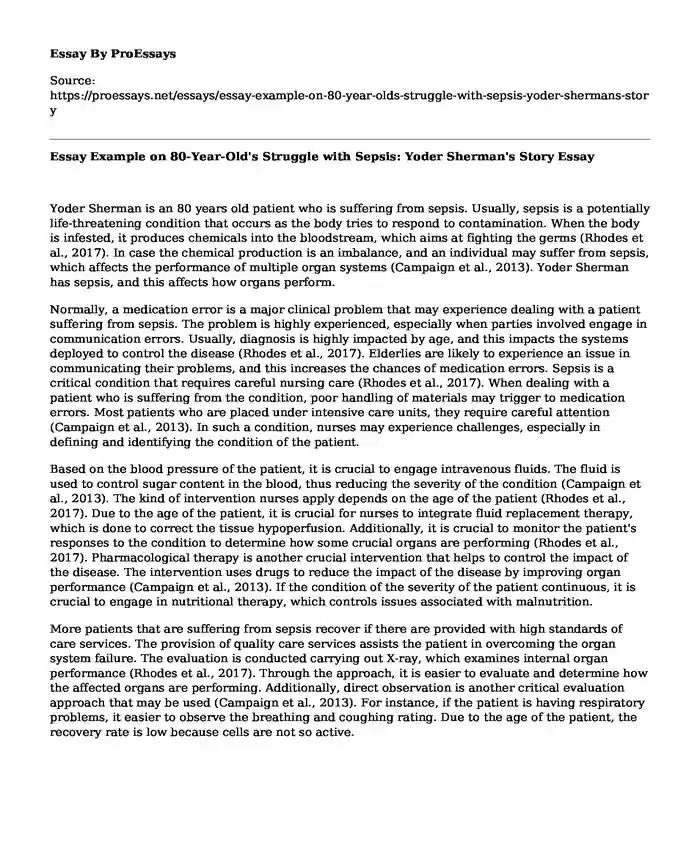Yoder Sherman is an 80 years old patient who is suffering from sepsis. Usually, sepsis is a potentially life-threatening condition that occurs as the body tries to respond to contamination. When the body is infested, it produces chemicals into the bloodstream, which aims at fighting the germs (Rhodes et al., 2017). In case the chemical production is an imbalance, and an individual may suffer from sepsis, which affects the performance of multiple organ systems (Campaign et al., 2013). Yoder Sherman has sepsis, and this affects how organs perform.
Normally, a medication error is a major clinical problem that may experience dealing with a patient suffering from sepsis. The problem is highly experienced, especially when parties involved engage in communication errors. Usually, diagnosis is highly impacted by age, and this impacts the systems deployed to control the disease (Rhodes et al., 2017). Elderlies are likely to experience an issue in communicating their problems, and this increases the chances of medication errors. Sepsis is a critical condition that requires careful nursing care (Rhodes et al., 2017). When dealing with a patient who is suffering from the condition, poor handling of materials may trigger to medication errors. Most patients who are placed under intensive care units, they require careful attention (Campaign et al., 2013). In such a condition, nurses may experience challenges, especially in defining and identifying the condition of the patient.
Based on the blood pressure of the patient, it is crucial to engage intravenous fluids. The fluid is used to control sugar content in the blood, thus reducing the severity of the condition (Campaign et al., 2013). The kind of intervention nurses apply depends on the age of the patient (Rhodes et al., 2017). Due to the age of the patient, it is crucial for nurses to integrate fluid replacement therapy, which is done to correct the tissue hypoperfusion. Additionally, it is crucial to monitor the patient's responses to the condition to determine how some crucial organs are performing (Rhodes et al., 2017). Pharmacological therapy is another crucial intervention that helps to control the impact of the disease. The intervention uses drugs to reduce the impact of the disease by improving organ performance (Campaign et al., 2013). If the condition of the severity of the patient continuous, it is crucial to engage in nutritional therapy, which controls issues associated with malnutrition.
More patients that are suffering from sepsis recover if there are provided with high standards of care services. The provision of quality care services assists the patient in overcoming the organ system failure. The evaluation is conducted carrying out X-ray, which examines internal organ performance (Rhodes et al., 2017). Through the approach, it is easier to evaluate and determine how the affected organs are performing. Additionally, direct observation is another critical evaluation approach that may be used (Campaign et al., 2013). For instance, if the patient is having respiratory problems, it easier to observe the breathing and coughing rating. Due to the age of the patient, the recovery rate is low because cells are not so active.
Conclusion
The discharge of a patient is highly determined by their health status. The outcome of the patient determines whether the patient should be discharged (Campaign et al., 2013). In case an individual does not need inpatient care services, they may be discharged (Rhodes et al., 2017). Therefore, if the outcome illustrates that the organs that were affected are performing perfectively, the patient can be discharged to home base care.
References
Campaign, S. S., Dellinger, R. P., Levy, M. M., Rhodes, A., Annane, D., Gerlach, H., & Jaeschke, R. (2013). International guidelines for management of severe sepsis and septic shock: 2012. Crit Care Med, 41(2), 580-637. http://www.chimei.org.tw/main/cmh_department/57800/journal/2013/Microsoft%20PowerPoint%20-%2020130304%20Journal%20reading%20SSC%202012(PART1).pdf
Rhodes, A., Evans, L. E., Alhazzani, W., Levy, M. M., Antonelli, M., Ferrer, R., ... & Rochwerg, B. (2017). Surviving sepsis campaign: international guidelines for management of sepsis and septic shock: 2016. Intensive Care Medicine, 43(3), 304-377. https://link.springer.com/article/10.1007/s00134-017-4683-6
Cite this page
Essay Example on 80-Year-Old's Struggle with Sepsis: Yoder Sherman's Story. (2023, Sep 11). Retrieved from https://proessays.net/essays/essay-example-on-80-year-olds-struggle-with-sepsis-yoder-shermans-story
If you are the original author of this essay and no longer wish to have it published on the ProEssays website, please click below to request its removal:
- Communicating Effectively Assessment Annotated Bibliography
- Health Program Planning and Evaluation Paper Example
- Diabetes Mellitus Type 1 Research Paper Example
- Essay on Unravelling Qualitative Research in Nursing: Analysing Approach, Interpretation and Presentation
- Essay Example on Equipping Nurses With Cognitive-Behavioral Therapy for Mental Health Care
- Essay Sample on Vitamin A: Essential for Vision, Growth and Immunity
- Social Work Ethics and Values Essay Example







